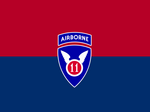| 11th Airborne Division | |
|---|---|
 | |
| Active | 1943–1958 1963–1965 2022–present |
| Country | |
| Branch | |
| Type | Airborne and Air Assault |
| Role | Arctic Warfare |
| Size | Division |
| Part of | Alaskan Command |
| Garrison/HQ | Joint Base Elmendorf-Richardson, Anchorage, Alaska |
| Nickname(s) | "Arctic Angels"[1] "Angels" (special designation) (hist.)[2] |
| Motto(s) | "Americas Arctic Angels-Arctic Tough"' |
| Colors | Maroon |
| Engagements | |
| Website | 11thairbornedivision.army.mil |
| Commanders | |
| Commanding General | MG Joseph Hilbert |
| Command Sergeant Major | CSM Vern B. Daley |
| Deputy Commanding General, Support | BG Thomas E. Burke |
| Deputy Commanding General, Operations | BGen Robert W. McBride (Canadian Army) |
| Notable commanders | Maj. Gen. Joseph M. Swing Lt. Gen. Ridgely Gaither Maj. Gen. Wayne C. Smith |
| Insignia | |
| Distinctive unit insignia |  |
| WWII airborne background trimming (Type 2) |  |
| Current airborne background trimming; a combination of the WWII and U.S. Army Alaska trimming |  |
| Flag |  |
The 11th Airborne Division ("Arctic Angels"[1]) is a United States Army airborne formation based in Alaska.
First activated on 25 February 1943, during World War II, it was held in reserve in the United States until June 1944 when it was transferred to the Pacific Theater where it saw combat in the Philippines. On 30 August 1945 the division was sent to southern Japan as part of the occupation force where it remained for four years. One parachute infantry regiment was detached for service in the Korean War, but on 30 June 1958 the division was inactivated.
In the summer of 2022 the U.S. Army Alaska headquarters was redesignated as the 11th Airborne Division, and the two Brigade Combat Teams in Alaska, the 1st Brigade Combat Team and 4th Brigade Combat Team, 25th Infantry Division, were transferred to the 11th Airborne Division and redesignated as the 1st and 2nd Infantry Brigade Combat Team of the 11th Airborne Division.[4]
- ^ a b Babb, Carla (6 June 2022). "Army Resurrects WWII-Era Airborne Division in Alaska". VOA. Retrieved 15 June 2022.
- ^ "Special Unit Designations". United States Army Center of Military History. 21 April 2010. Archived from the original on 9 June 2010. Retrieved 24 June 2010.
- ^ http://www.history.army.mil/html/forcestruc/cbtchron/abdcomp.html Archived 13 May 2017 at the Wayback Machine Component Elements of Airborne Divisions in World War II
- ^ "Army Creating Second Paratrooper Division as Service Forges New Identity for Arctic Troops". Military.com. 5 May 2022. Retrieved 5 May 2022.